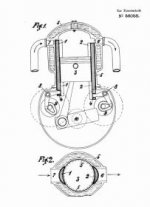I have the biography of Sir Harry Ricardo, and in it, he mentions working with sleeve valve engines. No mention of the Fischer sleeve valve system, only the Knight system.
Years ago, a fellow who was then an older man told me about driving a car with the sleeve valve engine. He did not own the car, but was going on a long trip with the car's owner, so shared the driving. As he told it, the sleeve valve engine was quiet and a lot smoother running than the conventional-design auto engines in cars he had owned or driven. He said the sleeve valve engine ran fine and they were able to drive at what- for the times and road conditions- was a high rate of speed. He also said the sleeve valve engine left a cloud of blue oil smoke in its wake, and they had to check/top up the crankcase oil at each gas stop.
I have an old book on my shelf called "Dr. ************'s Automotive Encyclopedia", from the 'teens. It does cover the Knight sleeve valve engines. What struck me when I looked over that part of the book was the impossibility in getting a good seal on the sleeves, as well as the inevitablity of high oil consumption. At the time the sleeve valve engines were being developed, automobile engines and I/C engines in general were in their infancy. Looking at the old engine designs, there was little or no thought given as to improving the flow of air/fuel mixture into the cylinder and the exhaust out of it. Seeing a cross section of a Pierce-Arrow engine of that time period will confirm just how inefficient engine designs were for that time period. Most engines of that time period were flathead, and many designs looked like it was a matter of making the parts fit and hold together moreso than taking combustion chamber design or gas flow into account. I always get a chuckle at the "headless" side-valve engines of the early days. Some had nothing more than pipe plugs over each valve to enable machining of the valve seat and guide, as well as servicing the valves.
The sleeve valve engine was likely arrived at as a mean to improve gas flows in and out of the cylinders and get a more precise timing or control of the events happening in the cylinders. From what I have seen the sleeve valve engines were quite a bit more complex than the side valve engines of the same time period. Getting a reasonable seal between the walls of the sleeves and the cylinder wall and block was probably an impossibility in those days, and the best that could be hoped for was a "good close fit". With that "good close fit", the danger of the sleeves seizing was likely addressed by the use of mechanical lubricators- such as are used on compressors, steam engines, and large slow speed diesels.
Sir Harry Ricardo did quite a bit of research into improving the efficiency and performance of I/C engine for autos, planes, tanks, motorcycles and much else. He and his firm developed an improved combustion chamber for the side-valve (aka "flathead") engines, and it did wonders as far as improving performance and efficiency. The "Ricardo Head" was patented, and companies bought licenses to use it, including some US auto makers. I think once Ricardo had begun research and improvements to combustion chamber design and related design such as manifolds, valves, etc, the need for the sleeve valve engines was reduced if not eliminated. Ricardo's firm continued their work into the era of overhead valve engines and may still be in business. I will pull the biography of Sir Harry Ricardo off the shelf tonight and see what I turn up in a re-read about sleeve valve engines.



